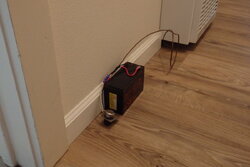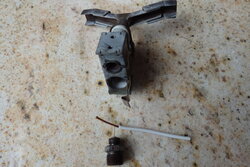We have a Williams wall furnace and last Thursday the furnace wouldn't turn on. I found the pilot light was off and that's never happened before. I relit the pilot and measured 200 millivolts at the valve while the manual said that around 450 was normal. 200 was enough to keep the pilot on but as soon as the t-stat called for heat the pilot would shut down. I went to 3 different hardware stores but no one had a replacement millivolt generator in stock so I had to order one and it is not supposed to be here until tomorrow.
So desperate times call for desperate measures and here's what I came up with. I got the small 12 volt 7AH battery that I use for my portable fish finder and wired in a potentiometer so that the voltage could be adjusted. I set the voltage to almost zero and then connected it to the valve and slowly dialed the voltage up to 450mv.
We turned on the t-stat and the furnace fired right up and has been working perfectly like this since.
I don't know if I'm an idiot or a mad genius for doing this but we're warm and my wife thinks I'm a hero so that's really all that maters. I do turn off the t-stat and disconnect the battery at night and whenever we leave the house.

So desperate times call for desperate measures and here's what I came up with. I got the small 12 volt 7AH battery that I use for my portable fish finder and wired in a potentiometer so that the voltage could be adjusted. I set the voltage to almost zero and then connected it to the valve and slowly dialed the voltage up to 450mv.
We turned on the t-stat and the furnace fired right up and has been working perfectly like this since.
I don't know if I'm an idiot or a mad genius for doing this but we're warm and my wife thinks I'm a hero so that's really all that maters. I do turn off the t-stat and disconnect the battery at night and whenever we leave the house.




